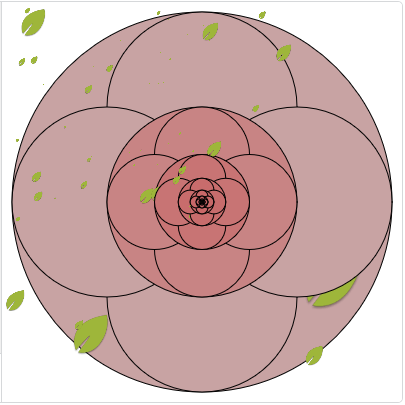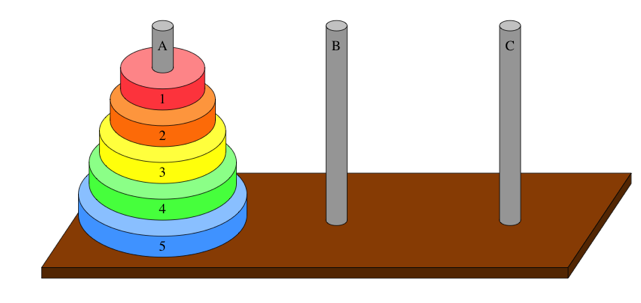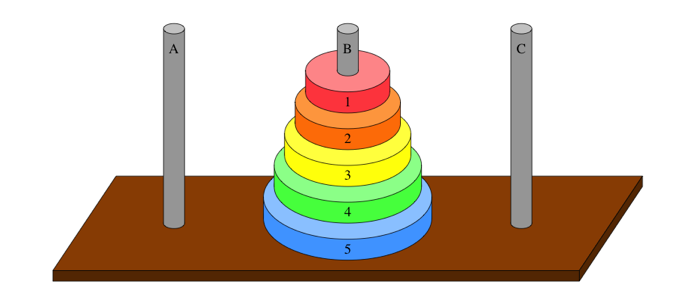1. Each recursive call should be on a smaller instance of the same problem, that is, a smaller subproblem.
2. The recursive calls must eventually reach a base case, which is solved without further recursion.
1. 计算阶乘n!
Javascript:
var factorial = function(n) { // base case: if(n===0) { return 1; } // recursive case: return(n*factorial(n-1)); }; println("The value of 0! is " + factorial(0) + "."); println("The value of 5! is " + factorial(5) + ".");
Python3:
def factorial(n): #base case if n == 0: return 1 #recursive case return (n*factorial(n-1)) print("The result of 5! is", factorial(5))
2. 回文串的判断
1. If the string is made of no letters or just one letter, then it is a palindrome.(如果字符串至多只有一个字符,那么这是一个回文串)
2. Otherwise, compare the first and last letters of the string.(否则[字符数大于1时],比较字符串的第一个字符和最后一个字符是否相等)
3. If the first and last letters differ, then the string is not a palindrome.(如果首尾字符不相同,则该字符串不是回文串)
4. Otherwise, the first and last letters are the same. Strip them from the string, and determine whether the string that remains is a palindrome.(首尾相同,则去头去尾,重复1-3的判断)
5. Take the answer for this smaller string and use it as the answer for the original string.(原字符串是否回文串,答案和在算法过程中其产生的子字符串是否回文串的答案相同)
Javascript:
// Returns the first character of the string str var firstCharacter = function(str) { return str.slice(0, 1); }; // Returns the last character of a string str var lastCharacter = function(str) { return str.slice(-1); }; // Returns the string that results from removing the first // and last characters from str var middleCharacters = function(str) { return str.slice(1, -1); }; var isPalindrome = function(str) { // base case #1 if(str.length <2){ return true; } // base case #2 if(firstCharacter(str) !== lastCharacter(str)){ return false; } // recursive case return(isPalindrome(middleCharacters(str))); };
Python:
def isPalindrome(string): # base case #1 if len(string) < 2: return True # base case #2 if string[0] != string[-1]: return False # recursive case return isPalindrome(string[1:(len(string)-1)]) testStr = ['a'] testStr.append("hfeK") testStr.append("HeyyeH") for i in range(3): print("Is string [", testStr[i], "] Palindrome?\n") print(isPalindrome(testStr[i]))
3. 求$x$的幂级数$x^n$
1). The base case is when $n=0$, and x^0 = 1(基本的情况是$n = 0$也就是$x^n=1$时)
2). If $n$ is positive and even, recursively compute $y = x^{n/2}$, and then $x^n = y \cdot y$ . Notice that you can get away with making just one recursive call in this case, computing $x^{n/2}$ just once, and then you multiply the result of this recursive call by itself.(如果$n$是偶数,那么可以只计算一次$x^{n/2},调用一次递归计算结果$)
3). If $n$ is positive and odd, recursively compute $x^{n-1}$, so that the exponent either is 0 or is positive and even. Then, $x^n = x^{n-1} \cdot x$(如果$n$是正的奇数,那么递归地计算$x^{n-1}$,这个指数要么是0要么成为正的偶数,则$x^n = x^{n-1} \cdot x$)
4). If $n$ is negative, recursively compute $x^{-n}$, so that the exponent becomes positive. Then,$x^n = 1 / x^{-n}$.(如果$n$是负数,那么递归计算$x^{-n}$,则此时指数为正数)
Javascript:
var isEven = function(n) { return n % 2 === 0; }; var isOdd = function(n) { return !isEven(n); }; var power = function(x, n) { println("Computing " + x + " raised to power " + n + "."); // base case if(n===0){ return 1; } // recursive case: n is negative if(n<0){ return 1/(power(x, -n)); } // recursive case: n is odd if(isOdd(n)){ return x*power(x, n-1); } // recursive case: n is even if(isEven(n)){ var temp = power(x, n/2); return temp*temp; } }; var displayPower = function(x, n) { println(x + " to the " + n + " is " + power(x, n)); }; displayPower(3, 0); Program.assertEqual(power(3, 0), 1);
Python:
def power(x, n): # base case if n==0: return 1 # recursive case: n is negative if n<0: return 1/(power(x, -n)) # recursive case: n is odd if n%2 != 0: return x*power(x, n-1) # recursive case: n is even if n%2 == 0: temp = power(x, n/2) return temp*temp x=4 for i in range(5): print(x, "to the power", i, "is", power(x, i))
4. 利用递归画画:
Javascript:
var drawShape = function(x, y, radius) { fill(200, 100+radius/6, 100+radius/6); ellipse(x, y, radius, radius); //add some leaves for(var i = 0; i < 10; i++){ var area = random(0, radius/4); image(getImage("avatars/leaf-green"), random(0, x+radius/2), random(0, y+radius/2), area, area); } //add the circles upside, leftside, rightside and downside ellipse(x, y-radius/4, radius/2, radius/2); ellipse(x, y+radius/4, radius/2, radius/2); ellipse(x+radius/4, y, radius/2, radius/2); ellipse(x-radius/4, y, radius/2, radius/2); var newRadius = radius/2; //recursively call the draw function if (newRadius >= 2) { //rotate(10); drawShape(x, y, newRadius); } }; drawShape(width/2, height/2, 380);
效果如下(想让叶子换下角度,圆也是,但是加上rotate之后图就乱了,暂时没有去琢磨):

5.汉诺塔:
说明:

把A柱子的圆盘,按原来的顺序摆放到B柱子上:

在这个过程中要遵守两个规则:
1. 每次只能移动一个盘子;
2. 大的盘子不能放在小盘子的下面。
如果只有一个盘子,那么直接移动就可以了;
如果有1、2两个盘子,那么可以先把盘子1放到C -> 把盘子2放到B -> 把盘子1放到B,完成。
而对于更多的盘子:1,2,...,n,则先递归地把盘子们1-(n-1)放到C -> 把盘子n放到B -> 递归地把盘子们1-(n-1)放到B。
假设移动k个盘子需要$a_k$步,则移动(k+1)个盘子需要$a_k + 1 + a_k = 2*a_k +1$步。则$a_{k+1} = 2*a_k +1$,从而$(a_{k+1}+1) = 2*(a_k +1)$
而$a_1 = 1$
则$a_k +1= 2^k$,$a_k = 2^k -1$
Javacript:
这里只给出一个框架,具体的移动时表现的内容没有加进来。
var solveHanoi = function(numDisks, fromPeg, toPeg) { // base case: no disks to move if(numDisks === 0){ return 0; } // recursive case: var sparePeg = hanoi.getSparePeg(fromPeg, toPeg); solveHanoi(numDisks-1, fromPeg, sparePeg); hanoi.moveDisk(fromPeg, toPeg); solveHanoi(numDisks-1, sparePeg, toPeg); };
Python:
def move(fromPeg, toPeg): print(fromPeg, "->", toPeg, "\n") def HanoiMove(numDisks, fromPeg, toPeg): sparePeg = ['A', 'B', 'C'] # define the spare peg sparePeg.remove(fromPeg) sparePeg.remove(toPeg) # the base case: no disk to move if numDisks == 0: return 0 # recursive case HanoiMove(numDisks-1, fromPeg, sparePeg[0]) move(fromPeg, toPeg) HanoiMove(numDisks-1, sparePeg[0], toPeg) HanoiMove(3, 'A', 'B')
打印结果如下:
A -> B A -> C B -> C A -> B C -> A C -> B A -> B


